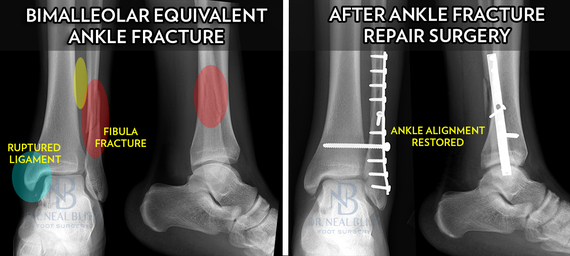
Not every broken ankle requires surgery; however, it's important to have a better understanding of when surgery is needed. Neglecting a broken ankle could lead to ankle arthritis and/or structural deformity -- both of which can cause disability and chronic pain.
What Is A Broken Ankle?
Ankle fractures are generally the result of a trauma or injury. An ankle fracture (which is synonymous with a broken ankle) means that one of the ankle bones has cracked. The crack can be subtle and show up faintly on the X-ray. The crack can be through-and-through the entire bone(s) -- completely separating the once intact bone(s). While the ankle is made up of two leg bones (tibia and fibula) and one foot bone (talus), only injury to the leg bones are truly considered an ankle fracture.
When Is Ankle Fracture Serious?
Surgeons decide if an ankle fracture requires surgery based on the extent of the injury and the "fracture pattern" -- which can be confusing for the average person. To simplify things, there are three criteria that guide a need for ankle fracture surgery, which are as follows:
3 Criteria For Ankle Fracture Surgery:
1. Fracture Gapping
2. Displacement
3. Instability
1. Ankle Fracture With Bone Gapping
In general, fractures where the fractured bone has separated from its parent bone enough that it would make bone healing difficult often require surgery. Fractured bone segments need to be "next" to each other in order to heal properly. Bones that are separated makes it more difficult for the bones to mend together, and instead of heal, may form a nonunion -- which is a scar tissue cap that forms in the fracture space rather than solid bone. In generally fractures displaced more than 2-3 millimeters should be closely evaluated for surgical repair to get the bone ends touching.
2. Ankle Fracture Displacement
Broken bones may break, but when they separate and change the alignment of the foot to the leg are more serious injuries. If an ankle fracture heals in an incorrect position, called a malunion, this may create a structural malalignment that could lead to biomechanical issues as well as promote ankle arthritis. Typically displaced ankle fractures require surgery.
3. Ankle Fracture Instability
An ankle bone may be badly broken but the overall position and alignment of the fracture looks good, but the ankle is rendered structurally unstable. Unstable ankle fractures generally require surgery. In some cases surgeons will perform manipulation (stress exams) to test for fracture stability.
What Is Ankle Fracture Surgery
Ankle fracture surgery most commonly involves placing surgical hardware (metal screws with or without metal plates) into and/or around the ankle bone(s). Ankle fractures are generally rotary injuries and can involve a combination of bone fractures and ligament injury/rupture.
The purpose of ankle fracture surgery, from a surgeon's perspective, is to reduce or eliminate any fracture gapping, improve the alignment of the fractured bone(s) and/or provide structural stability while the bones mend.
The good news is that not all ankle fractures require surgery. When surgery is needed, it is important to recognize that surgery does not generally affect healing time, as bones typically heal within 6-8 weeks. Generally surgery is utilized to improve (or guide the outcome) of the bodys natural healing process. Improperly healed bones may be painful themselves. Poorly-aligned bones many create biomechanical pain and discomfort. Long-term consequences of any ankle fracture may lead to ankle arthritis, though certain fracture patterns (especially those that invade or crush the ankle joint cartilage) may be more likely to develop post-traumatic ankle arthritis.
Dr. Neal Blitz
Reconstructive Foot & Ankle Surgery
New York City
To learn more about Ankle Fracture Surgery Manhattan, please visit www.BunionSurgeryNY.com
Circle +NealBlitz on Google +

